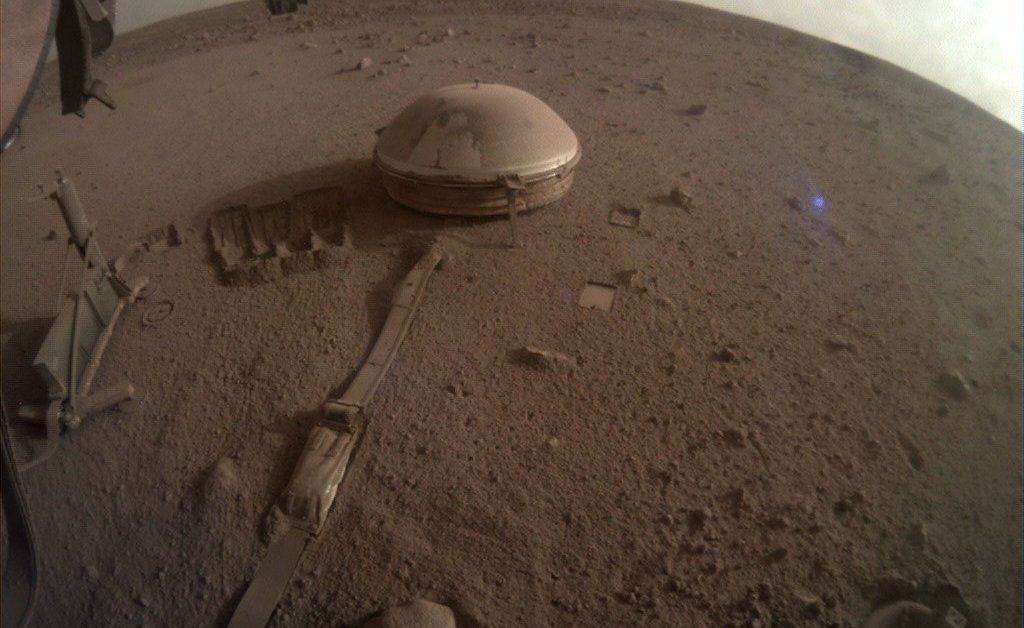The tweet that came from Mars Monday morning actually didn’t originate from anywhere near there. It came from NASA’s Jet Propulsion Laboratory in Pasadena, Calif., where the mission of the Mars InSight lander is managed. Still, the message was a poignant one.
“My power’s really low,” read the tweet, which was accompanied by a picture taken by the spacecraft, “so this may be the last image I can send. Don’t worry about me though: my time here has been both productive and serene. If I can keep talking to my mission team, I will—but I’ll be signing off here soon. Thanks for staying with me.”
NASA has managed a Twitter feed posting messages “from” InSight ever since the spacecraft landed on the Red Planet on Nov. 26, 2018, for a mission that was supposed to last just shy of two Earth years, but actually more than doubled that. In its time on Mars, InSight has performed stoically—weathering accumulations of dust that partially obscured its solar panels (and that finally overcame them with the shutdown Monday) and breakdowns that prevented one of its key instruments from working as it should. But nonetheless over its lifetime the spacecraft beamed back a wealth of data principally about the Martian interior.
InSight was built to do more than study Mars alone; it was designed to provide new clues to planetary evolution as a whole. Earth, which has active plate tectonics, is forever erasing and re-erasing its internal history. Look deeply into our planet and you’ll have little clue as to just what its geologic anatomy was in its first billion or two billion years. Mars, however, which is just over half the diameter of Earth, is big enough to have experienced internal heating and separation into layers—core, mantle, and crust—but small enough to have cooled off and lost its plate tectonics after a comparatively brief passage of geologic time, just a billion years or so. It thus serves as something of a cosmic fossil, retaining the interior structure it had in its relative infancy. As a result, looking inside Mars is a little like looking inside Earth—and similarly sized Venus—three billion years ago.
“Within its own structural signature,” NASA wrote in its overview of the mission, “Mars may contain the most in-depth and accurate record in the solar system of [geologic] processes.”
To study those processes, the spacecraft was equipped with a seismometer; a 40 cm (16 in.) probe—nicknamed “the mole”—designed to be hammered 5 m (16 ft.) into the Martian surface to measure heat loss; a radio sensor that could detect planetary motion, providing data about Mars’s mass and density; a magnetometer to study the planet’s magnetic history field; and multiple cameras to help guide its work.
That bounty of hardware produced an equal bounty of data, as NASA reports. InSight became the first ever spacecraft to detect seismic activity on Mars, recording over 1,300 active marsquakes, including 50 that were powerful enough that researchers could pinpoint their location. The strongest quakes originated from a region known as Cerebrus Fossae, an unusually active geologic zone that is thought to have experienced volcanism within the past two million years. The most powerful quake InSight detected was a magnitude 5 on May 4, 2022, which left the planet vibrating for a full six hours.
One magnitude 4 quake recorded last year was caused by a meteorite hit. To study that one, InSight worked together with NASA’s Mars Reconnaissance Orbiter circling the planet overhead. That ship captured images of the site of the impact, revealing that the meteorite had exposed a layer of water ice lying just beneath the surface—showing that Mars may be a wetter world than it is commonly thought to be.
The spacecraft measured the thickness of all of Mars’s layers by bouncing seismic waves into the interior and analyzing their reflection. The planet’s crust, InSight found, is thinner than scientists believed it would be—just 25 to 40 km (15 to 25 mi.) deep. Its molten core, on the other hand, is surprisingly large—about 3,600 km (2,240 mi.) in diameter—for a planet that measures only 6,779 km (4,212 mi.) across.
While Mars lost its magnetic field about four billion years ago when its core cooled sufficiently that it stopped spinning relative to the layers above it, InSight found what NASA terms “ghosts” of that magnetism preserved in rocks ranging from 61 m (200 ft.) to several miles below ground. The intensity of the magnetism turned out to be 10 times greater than orbiting spacecraft had measured, suggesting that the now-vanished magnetic field may have been stronger than once believed.
The mission’s one failure involved its 40 cm probe. A pile driver-like device was designed to hammer the probe into the surface, but the Martian soil kept clumping around the probe, depriving it of the friction it needed to bury itself anywhere near the 5 m depth it was supposed to achieve. In January 2021, mission managers gave up the effort, with the probe never getting any deeper than 0.35 m (1.1 ft.) into the surface.
“We’ve given it everything we’ve got, but Mars and our heroic mole remain incompatible,” said principal investigator Tilman Spohn in a statement at the time. “Fortunately, we’ve learned a lot that will benefit future missions that attempt to dig into the subsurface.”
Those future missions are sure to come. For now, InSight—like the Viking landers and the Spirit and Opportunity rovers and other Martian spacecraft that have come before it—has gathered its data and lived out its life. What was once an extraterrestrial science lab is now a silent and permanent monument to humanity’s boundless curiosity about the cosmos.
More Must-Reads From TIME



